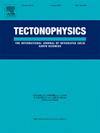Characterization of seismogenesis beneath the Tripura Fold Belt and its adjoining areas of Northeast India
IF 2.7
3区 地球科学
Q2 GEOCHEMISTRY & GEOPHYSICS
引用次数: 0
Abstract
In this study, a comprehensive analysis comprising the relocation of ∼400 well-located earthquakes (M ≤ 4.9) recorded during 2013–2015 and 19-moment tensor solutions has been made. The earthquakes were recorded by 20 seismographic stations belonging to the Geological Survey of India (GSI) and National Centre for Seismology (NCS) networks. Then, the results are corroborated with the geophysical and geological investigations for the areas that need better characterization of the seismotectonics beneath the Tripura Fold Belt (TFB) and its adjoining areas in Northeast (NE) India. The sparse seismicity distribution associated with TFB shows north-south trending anticlinal ridges and synclinal valleys. These structures decrease progressively towards the south and are confined to depths between 40 and 60 km. The mixed mode of faulting at various depths indicates significant structural heterogeneity beneath TFB that dictates the earthquake strength. We conspicuously relocated earthquakes in a cluster along the Sylhet fault (SF) with a dominant northeast striking, suggesting the presence of differential structural heterogeneities with variable strengths of earthquakes located at varying depths, which in turn indicates that the seismogenesis beneath the Sylhet fault is associated with thrust mode of faulting with distinct slip component during the processes of the rupture initiation. Moment tensor solution of the area inferred two main directions: NNE –SSW and WNW – ESE, suggesting two compressive forces acting in the study area. The NNE-SSW compressional stress is dominant in this zone. This study provides deep insights into the two different structural entities, TFB and SF of NE India, that can have the potential to contribute significantly for assessing the earthquake risk potential of the region.
印度东北部特里普拉褶皱带及其邻近地区的地震成因特征
在这项研究中,对2013-2015年记录的~ 400次定位良好的地震(M≤4.9)和19矩张量解进行了综合分析。属于印度地质调查局(GSI)和国家地震学中心(NCS)网络的20个地震台记录了这些地震。然后,通过对印度东北部特里普拉褶皱带(TFB)及其邻近地区地震构造特征的物探和地质调查,对研究结果进行了验证。与TFB相关的稀疏地震活动性分布表现为南北走向的背斜脊和向斜谷。这些构造向南逐渐减少,并局限于40至60公里的深度。不同深度断层的混合模式表明TFB下明显的结构非均质性决定了地震强度。我们在以东北向为主的Sylhet断层(SF)上明显地重新定位了一组地震,表明在不同深度存在不同强度的不同构造非均质性,这反过来表明Sylhet断层下的地震发生与断裂起裂过程中具有明显滑动成分的断层冲断模式有关。该地区矩张量解推断出两个主要方向:NNE - ssw和WNW - ESE,表明研究区存在两种压缩力。北北东—南南西挤压应力在该区占主导地位。这项研究提供了对印度东北部两种不同结构实体的深刻见解,即TFB和SF,这可能对评估该地区的地震风险潜力做出重大贡献。
本文章由计算机程序翻译,如有差异,请以英文原文为准。
求助全文
约1分钟内获得全文
求助全文
来源期刊

Tectonophysics
地学-地球化学与地球物理
CiteScore
4.90
自引率
6.90%
发文量
300
审稿时长
6 months
期刊介绍:
The prime focus of Tectonophysics will be high-impact original research and reviews in the fields of kinematics, structure, composition, and dynamics of the solid arth at all scales. Tectonophysics particularly encourages submission of papers based on the integration of a multitude of geophysical, geological, geochemical, geodynamic, and geotectonic methods
 求助内容:
求助内容: 应助结果提醒方式:
应助结果提醒方式:


